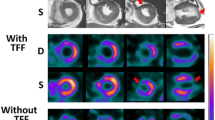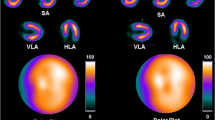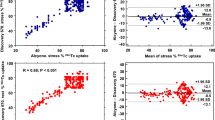Abstract
Background
Left ventricular (LV) ejection fraction (EF) during high dobutamine stress (HD) by real-time gated-SPECT myocardial perfusion imaging (MPI) on a cadmium-zinc-telluride (CZT) gamma camera was validated versus cardiac magnetic resonance imaging (CMR).
Methods and results
After injecting 99mTc-tetrofosmin (320 MBq) in 50 patients (mean age 64 +/− 11 years), EF at rest and post-stress as well as relevant changes in EF at HD (ΔEF ≥ 5%) were assessed. CZT and CMR rest EF values yielded an excellent correlation and agreement (r = 0.96; P < 0.001; Bland–Altman limits of agreement (BA): + 0 to 14.8%). HD EF acquisition was feasible using CZT and correlated better to HD CMR EF than did post-stress CZT EF (r = 0.85 vs 0.76, respectively, all P < 0.001). Agreement in ΔEF detection between HD CMR and immediate post-stress CZT (reflecting standard acquisition using conventional SPECT camera unable to scan during stress) was 45%, while this increased to 85% with real-time HD CZT scan.
Conclusion
Real-time ultrafast dobutamine gated-SPECT MPI with a CZT device is feasible and provides accurate measurements of HD LV performance.




Similar content being viewed by others
Abbreviations
- CMR:
-
Cardiac magnetic resonance imaging
- CZT SPECT:
-
Cadmium-zinc-telluride detectors single photon emission computed tomography
- LVWM:
-
Left ventricular wall motion
- LVWT:
-
Left ventricular wall thickening
- MPI:
-
Myocardial perfusion imaging
- TID:
-
Transient ischemic dilation
References
Nesto RW, Kowalchuk GJ. The ischemic cascade: temporal sequence of hemodynamic, electrocardiographic and symptomatic expressions of ischemia. Am J Cardiol. 1987;59:23C-30C.
Fleischmann S, Koepfli P, Namdar M, Wyss CA, Jenni R, Kaufmann PA. Gated (99m)Tc- tetrofosmin SPECT for discriminating infarct from artifact in fixed myocardial perfusion defects. J Nucl Med. 2004;45:754-9.
Go V, Bhatt MR, Hendel RC. The diagnostic and prognostic value of ECG-gated SPECT myocardial perfusion imaging. J Nucl Med. 2004;45:912-21.
Sharir T, Berman DS, Lewin HC, et al. Incremental prognostic value of rest-redistribution (201)Tl single-photon emission computed tomography. Circulation. 1999;100:1964-70.
Sharir T, Germano G, Kang X, et al. Prediction of myocardial infarction versus cardiac death by gated myocardial perfusion SPECT: risk stratification by the amount of stress-induced ischemia and the poststress ejection fraction. J Nucl Med. 2001;42:831-7.
Pratali L, Otasevic P, Neskovic A, Molinaro S, Picano E. Prognostic value of pharmacologic stress echocardiography in patients with idiopathic dilated cardiomyopathy: a prospective, head-to-head comparison between dipyridamole and dobutamine test. J Card Fail. 2007;13:836-42.
Quere JP, Monin JL, Levy F, et al. Influence of preoperative left ventricular contractile reserve on postoperative ejection fraction in low-gradient aortic stenosis. Circulation. 2006;113:1738-44.
Gambhir SS, Berman DS, Ziffer J, et al. A novel high-sensitivity rapid-acquisition single-photon cardiac imaging camera. J Nucl Med. 2009;50:635-43.
Herzog BA, Buechel RR, Katz R, et al. Nuclear myocardial perfusion imaging with a cadmium- zinc-telluride detector technique: optimized protocol for scan time reduction. J Nucl Med. 2010;51:46-51.
Geleijnse ML, Elhendy A, Fioretti PM, Roelandt JR. Dobutamine stress myocardial perfusion imaging. J Am Coll Cardiol. 2000;36:2017-27.
Buechel RR, Herzog BA, Husmann L, et al. Ultrafast nuclear myocardial perfusion imaging on a new gamma camera with semiconductor detector technique: first clinical validation. Eur J Nucl Med Mol Imaging. 2010;37:773-8.
Nkoulou R, Pazhenkottil AP, Kuest SM, et al. Semiconductor detectors allow low-dose-low- dose 1-day SPECT myocardial perfusion imaging. J Nucl Med. 2011;52:1204-9.
Bocher M, Blevis IM, Tsukerman L, Shrem Y, Kovalski G, Volokh L. A fast cardiac gamma camera with dynamic SPECT capabilities: design, system validation and future potential. Eur J Nucl Med Mol Imaging. 2010;37:1887-902.
Schepis T, Gaemperli O, Koepfli P, et al. Use of coronary calcium score scans from stand-alone multislice computed tomography for attenuation correction of myocardial perfusion SPECT. Eur J Nucl Med Mol Imaging. 2007;34:11-9.
Herzog BA, Buechel RR, Husmann L, et al. Validation of CT attenuation correction for high- speed myocardial perfusion imaging using a novel cadmium-zinc-telluride detector technique. J Nucl Med. 2010;51:1539-44.
Cerqueira MD, Weissman NJ, Dilsizian V, et al. Standardized myocardial segmentation and nomenclature for tomographic imaging of the heart: a statement for healthcare professionals from the Cardiac Imaging Committee of the Council on Clinical Cardiology of the American Heart Association. Circulation. 2002;105:539-42.
Bland JM, Altman DG. Statistical methods for assessing agreement between two methods of clinical measurement. Lancet. 1986;1:307-10.
Weiss AT, Berman DS, Lew AS, et al. Transient ischemic dilation of the left ventricle on stress thallium-201 scintigraphy: a marker of severe and extensive coronary artery disease. J Am Coll Cardiol. 1987;9:752-9.
McLaughlin MG, Danias PG. Transient ischemic dilation: a powerful diagnostic and prognostic finding of stress myocardial perfusion imaging. J Nucl Cardiol. 2002;9:663-7.
Semelka RC, Tomei E, Wagner S, et al. Interstudy reproducibility of dimensional and functional measurements between cine magnetic resonance studies in the morphologically abnormal left ventricle. Am Heart J. 1990;119:1367-73.
Bellenger NG, Davies LC, Francis JM, Coats AJ, Pennell DJ. Reduction in sample size for studies of remodeling in heart failure by the use of cardiovascular magnetic resonance. J Cardiovasc Magn Reson. 2000;2:271-8.
Grothues F, Smith GC, Moon JC, et al. Comparison of interstudy reproducibility of cardiovascular magnetic resonance with two-dimensional echocardiography in normal subjects and in patients with heart failure or left ventricular hypertrophy. Am J Cardiol. 2002;90:29-34.
Otterstad JE, Froeland G, St John Sutton M, Holme I. Accuracy and reproducibility of biplane two-dimensional echocardiographic measurements of left ventricular dimensions and function. Eur Heart J. 1997;18:507-13.
Bogaert JG, Bosmans HT, Rademakers FE, et al. Left ventricular quantification with breath- hold MR imaging: comparison with echocardiography. MAGMA. 1995;3:5-12.
Picano E, Lattanzi F, Orlandini A, Marini C, L’Abbate A. Stress echocardiography and the human factor: the importance of being expert. J Am Coll Cardiol. 1991;17:666-9.
Bailliez A, Blaire T, Mouquet F, et al. Segmental and global left ventricular function assessment using gated SPECT with a semiconductor cadmium zinc telluride (CZT) camera: phantom study and clinical validation vs cardiac magnetic resonance. J Nucl Cardiol. 2014;21:712-22.
Cochet H, Bullier E, Gerbaud E, et al. Absolute quantification of left ventricular global and regional function at nuclear MPI using ultrafast CZT SPECT: initial validation versus cardiac MR. J Nucl Med. 2013;54:556-63.
Ghadri JR, Pazhenkottil AP, Nkoulou RN, et al. Very high coronary calcium score unmasks obstructive coronary artery disease in patients with normal SPECT MPI. Heart. 2011;97:998-1003.
Ghadri JR, Fiechter M, Veraguth K, et al. Coronary calcium score as an adjunct to nuclear myocardial perfusion imaging for risk stratification before noncardiac surgery. J Nucl Med. 2012;53:1081-6.
Christian TF, Miller TD, Bailey KR, Gibbons RJ. Noninvasive identification of severe coronary artery disease using exercise tomographic thallium-201 imaging. Am J Cardiol. 1992;70:14-20.
Sharir T, Bacher-Stier C, Dhar S, et al. Identification of severe and extensive coronary artery disease by postexercise regional wall motion abnormalities in Tc-99m sestamibi gated single- photon emission computed tomography. Am J Cardiol. 2000;86:1171-5.
Lima RS, Watson DD, Goode AR, et al. Incremental value of combined perfusion and function over perfusion alone by gated SPECT myocardial perfusion imaging for detection of severe three-vessel coronary artery disease. J Am Coll Cardiol. 2003;42:64-70.
Narula J, Dawson MS, Singh BK, et al. Noninvasive characterization of stunned, hibernating, remodeled and nonviable myocardium in ischemic cardiomyopathy. J Am Coll Cardiol. 2000;36:1913-9.
Barnes E, Dutka DP, Khan M, Camici PG, Hall RJ. Effect of repeated episodes of reversible myocardial ischemia on myocardial blood flow and function in humans. Am J Physiol Heart Circ Physiol. 2002;282:H1603-8.
Acknowledgements
We would like to thank Ennio Mueller, Edlira Loga, Myriam De Bloome, Sabrina Epp, and Patrick von Schulthess for their excellent technical support. Philipp A Kaufmann was supported by a grant from the Swiss National Science Foundation (SNSF).
Disclosures
None declared.
Author information
Authors and Affiliations
Corresponding author
Additional information
The authors of this article have provided a PowerPoint file, available for download at SpringerLink, which summarises the contents of the paper and is free for re-use at meetings and presentations. Search for the article DOI on SpringerLink.com.
Electronic supplementary material
Below is the link to the electronic supplementary material.
Rights and permissions
About this article
Cite this article
Nkoulou, R., Wolfrum, M., Pazhenkottil, A.P. et al. Gated SPECT myocardial perfusion imaging with cadmium-zinc-telluride detectors allows real-time assessment of dobutamine-stress-induced wall motion abnormalities. J. Nucl. Cardiol. 26, 1734–1742 (2019). https://doi.org/10.1007/s12350-018-1187-x
Received:
Accepted:
Published:
Issue Date:
DOI: https://doi.org/10.1007/s12350-018-1187-x




